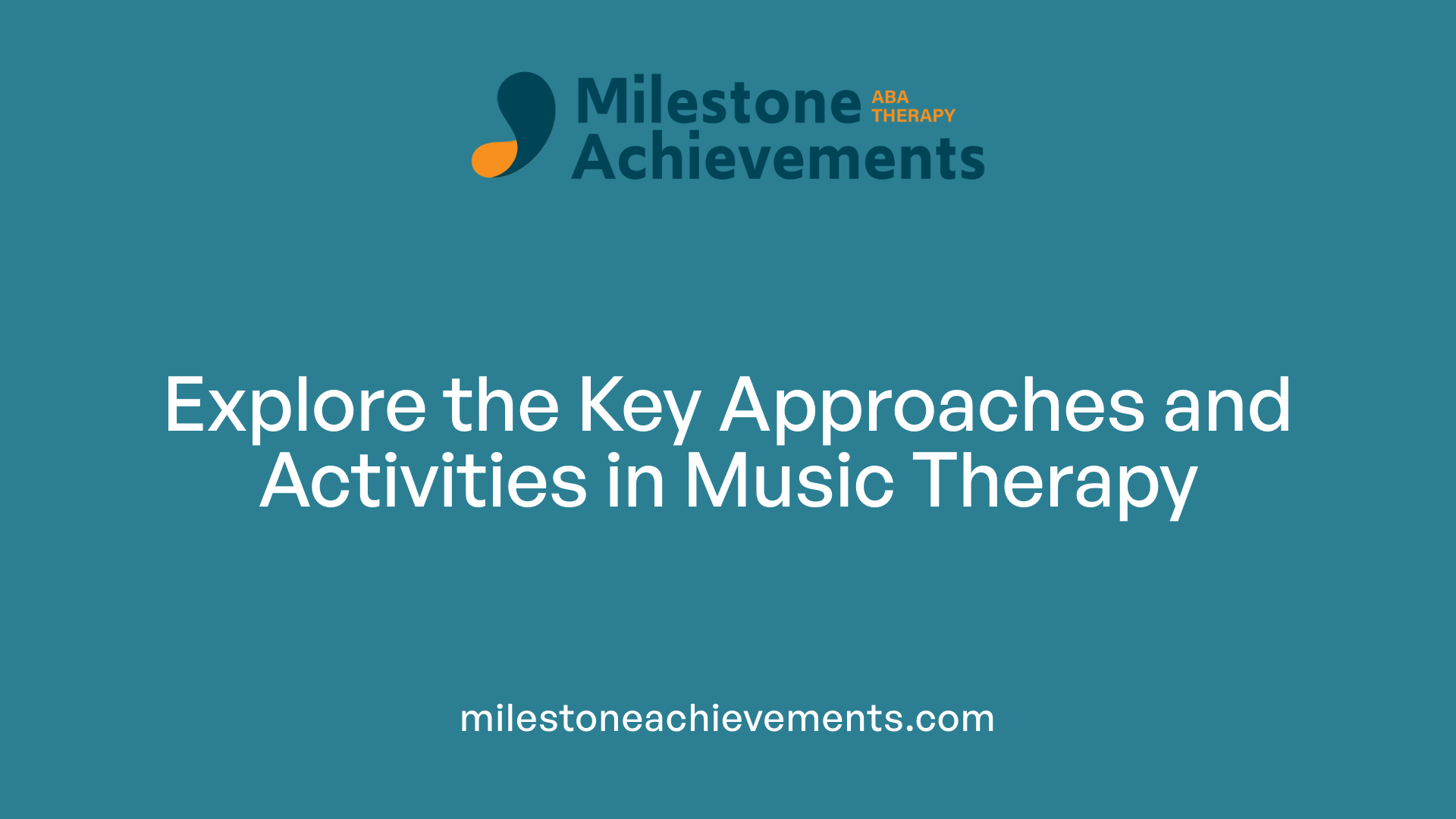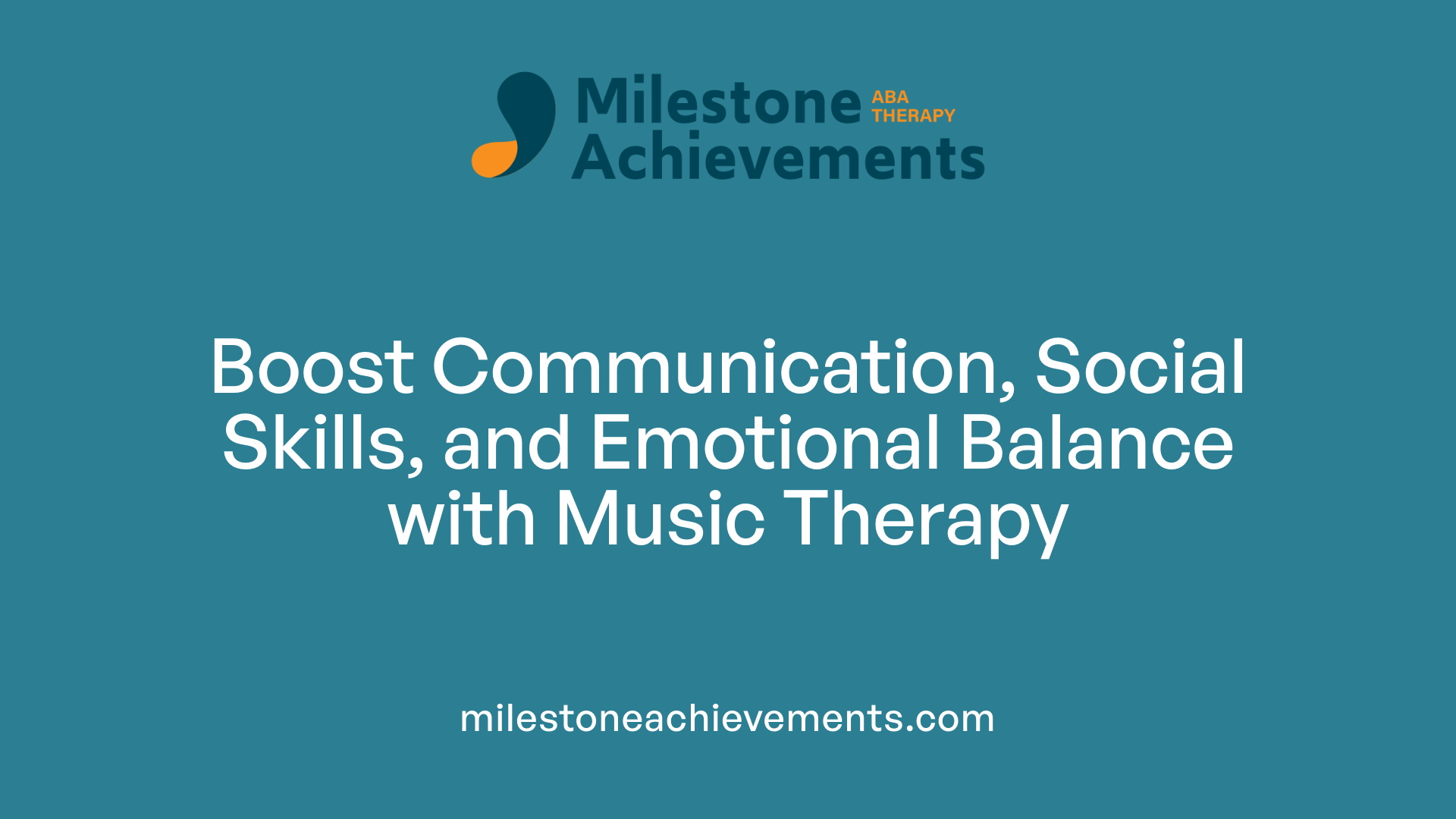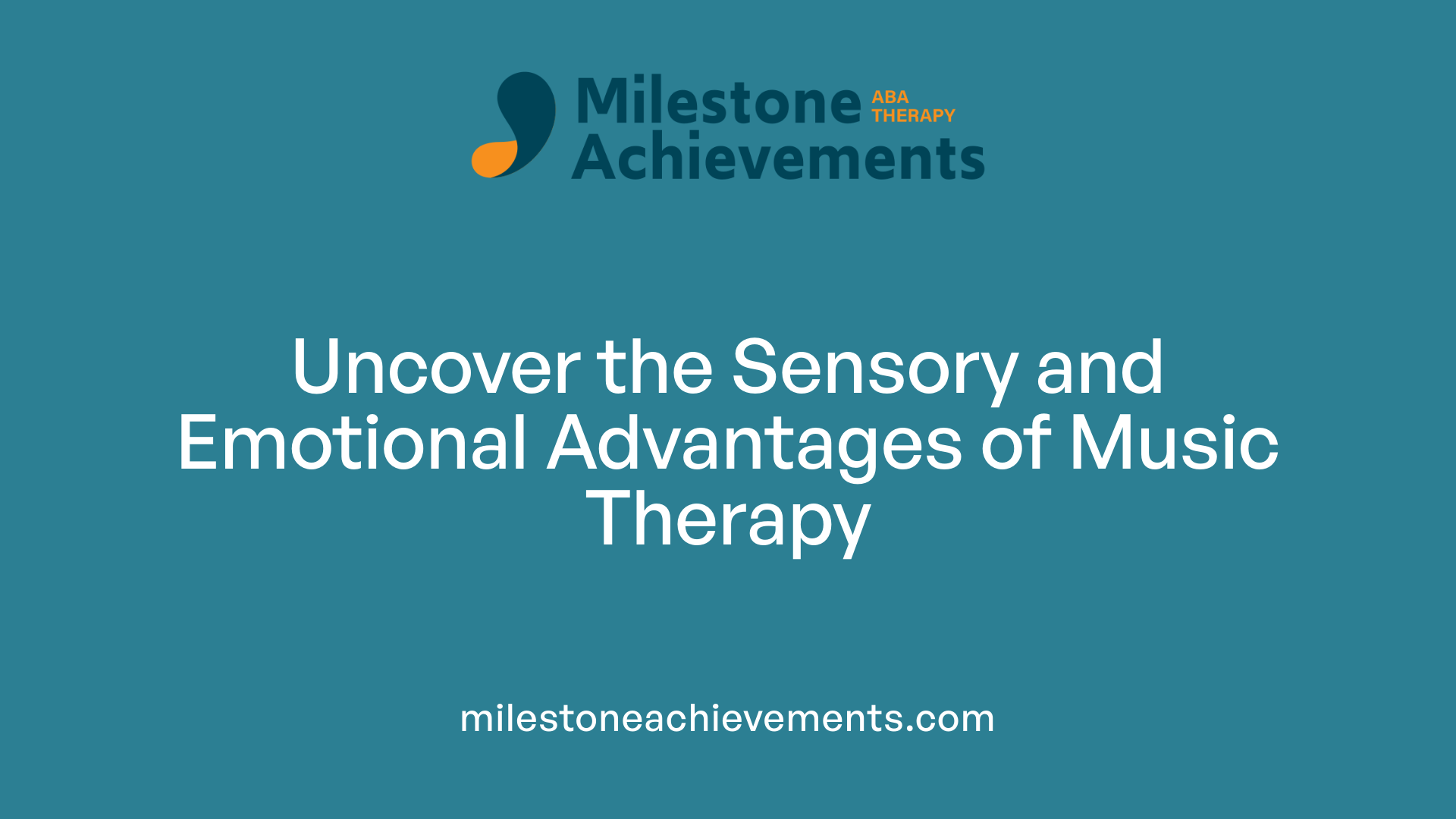Benefits of Music Therapy for Autism
Harmonizing Development: Unlocking the Power of Music in Autism Support

Exploring the Transformative Impact of Music Therapy on Autism Spectrum Disorder
Music therapy has emerged as a compelling, evidence-based approach to supporting individuals with autism spectrum disorder (ASD). Harnessing the innate responsiveness many autistic individuals have to music, this therapeutic modality offers a multifaceted avenue for enhancing communication, social skills, emotional regulation, and sensory processing. This article delves into the therapeutic approaches, supported by scientific evidence, that demonstrate how music therapy can significantly improve the quality of life and developmental outcomes for those on the autism spectrum.
Multidimensional Benefits of Music Therapy in Autism
What are the benefits of music therapy for individuals with autism?
Music therapy provides a wide range of positive effects for individuals on the autism spectrum. It enhances verbal and nonverbal communication skills, allowing children and adults to express feelings and needs more effectively. Activities like singing, playing instruments, and improvisation foster self-expression and emotional awareness.
Beyond communication, music therapy encourages social interaction. Group sessions promote shared experiences, turn-taking, and joint attention, which are critical for social development. Many individuals report increased confidence and enjoyment during these interactions.
Emotionally, music therapy helps regulate stress and anxiety. It activates neurotransmitters that induce feelings of calm and happiness, reducing emotional distress and challenging behaviors such as meltdowns.
Furthermore, the structured and sensory-rich environment of music therapy supports cognitive development, including attention, memory, and problem-solving skills. It also strengthens motor skills through rhythm and movement exercises.
Overall, music therapy enhances emotional wellbeing, social connections, and developmental progress, significantly improving quality of life for individuals with autism.
Core Therapeutic Approaches and Activities in Music Therapy

What therapeutic approaches and activities are involved in music therapy for autism?
Music therapy for individuals with autism employs an array of approaches and activities tailored to meet each person's unique needs. These activities include singing, the use of musical instruments, songwriting, improvisation, and listening to both live and recorded music.
Therapists often utilize free improvisation, where the client leads the musical creation, and structured improvisation to encourage spontaneous expression and social interaction. Musical games are incorporated to promote turn-taking, joint attention, and social reciprocity. Sensory exploration activities involve engaging with various musical elements—such as rhythm, melody, and sound textures—to support sensory processing challenges common in autism.
Sessions can be conducted one-on-one, in group settings, or even with family members, fostering a supportive environment for social development. Relational strategies emphasize building a trusting relationship, while improvisational techniques encourage creativity, emotional expression, and engagement.
Throughout therapy, practitioners monitor behavioral changes and progress to ensure the goals—such as improving communication, emotional regulation, and social skills—are achieved. The systematic structure of music therapy harnesses the motivating and organizing properties of music, making it a compelling intervention for supporting developmental and behavioral growth.
Overall, music therapy integrates evidence-based practices with personalized musical experiences to create meaningful improvements for individuals with autism.
What are the most effective therapeutic strategies used in music therapy for autism?
The most successful approaches in music therapy for autism focus on relational and improvisational techniques that align with clinical best practices. Client-led improvisation is central, allowing individuals to create and respond freely, fostering a sense of agency and comfort.
Musical games that promote turn-taking, shared attention, and reciprocity help build foundational social skills. Tailoring music to individual preferences and sensitivities boosts motivation and engagement, which are critical for effective intervention.
Sensory exploration through music helps address sensory integration difficulties by providing multisensory stimulation—auditory, visual, tactile, proprioceptive, and vestibular inputs—that can improve sensory processing.
In addition, songwriting and rhythmic exercises are used to enhance language abilities and coordination. These strategies create a safe, predictable environment where clients can build trust, develop self-confidence, and acquire new skills through positive musical experiences.
By emphasizing client-centered approaches and maintaining a flexible, responsive stance, therapists maximize the therapeutic benefits, supporting meaningful behavioral and developmental changes.
Scientific Evidence Supporting Music Therapy in Autism Interventions

What scientific evidence supports the benefits of music therapy for autism?
A substantial body of scientific research and clinical studies have demonstrated the positive impacts of music therapy for individuals with autism spectrum disorder (ASD). These studies reveal improvements in social skills, communication, emotional regulation, and sensory processing abilities.
Research indicates that music therapy actively engages clients through structured musical activities such as singing, instrument playing, improvisation, and listening. These approaches are tailored to meet individual needs and leverage the innate response many individuals with ASD have to music. Evidence shows that music therapy can help reduce anxiety, stress, and maladaptive behaviors, while boosting self-confidence, coping strategies, and overall quality of life.
Certified music therapists employ evidence-based techniques aligned with clinical best practices, focusing on fostering emotional and social growth. The consistent findings across multiple studies affirm that music therapy is a valuable, versatile intervention supported by ongoing scientific investigation. Its ability to influence mental, emotional, physical, social, and cognitive domains makes it a compelling component of comprehensive autism care.
What research outcomes demonstrate the effectiveness of music therapy?
Results from numerous randomized controlled trials (RCTs) and meta-analyses provide compelling evidence of music therapy’s benefits for autistic individuals. For instance, a comprehensive meta-analysis of 8 RCTs involving 608 children with ASD found significant improvements in social responsiveness, with increased social reactions and reciprocal interactions.
Furthermore, research has shown moderate effect sizes in enhancing communication skills, including speech and non-verbal communication, as well as sensory processing and self-help behaviors. Other studies report notable reductions in anxiety, stress, and distressed behaviors.
Assessment tools like the Social Responsiveness Scale (SRS-2), Autism Treatment Evaluation Checklist (ATEC), and Gibson Diagnostic Scale (GDS) are used to quantify improvements. These measures consistently demonstrate positive changes post-therapy, reinforcing the robustness of scientific evidence.
The findings point to measurable gains in social engagement, emotional regulation, and behavioral adaptation, illustrating that music therapy can significantly support the developmental needs of children and adults with ASD. The diversity and consistency of research outcomes affirm music therapy’s role as an effective, evidence-backed intervention.
| Research Outcome | Effect Size | Sample Size | Measurement Tools | Notable Findings |
|---|---|---|---|---|
| Social skills improvement | Moderate to large | 608 (meta-analysis) | SRS-2, ATEC | Increased social reactions and reciprocity |
| Communication skills | Significant | Varies | Speech and language assessments | Enhanced verbal and non-verbal communication |
| Sensory processing | Large | Multiple studies | Sensory integration tests | Better sensory regulation |
| Emotional regulation | Noted | Multiple studies | Emotional regulation scales | Reduced anxiety and stress |
| Maladaptive behaviors | Significant reduction | Various cohorts | Behavior checklists | Decrease in distressed behaviors |
More information
For those interested in the scientific foundations and latest developments in this field, search terms like "clinical research on music therapy outcomes in autism" can yield valuable insights. Continuing research underscores the importance of integrating music therapy into multidisciplinary strategies to support individuals with ASD, emphasizing a holistic approach to growth and development.
Enhancing Communication, Social Skills, and Emotional Regulation

How does music therapy improve communication, social skills, and emotional regulation in individuals with autism?
Music therapy serves as a powerful tool for fostering communication, social interaction, and emotional health in individuals with autism. It involves engaging participants in a variety of structured musical activities that promote natural interaction, imitation, and shared emotional experiences. Through singing, movement, instrument playing, and improvisation, individuals are encouraged to participate actively, which nurtures core social skills.
One of the primary benefits is the promotion of shared attention, where the individual and therapist focus on a musical activity together, creating a foundation for social engagement. Turn-taking is cultivated through activities like passing instruments or rhythmic exchanges, reinforcing patience and cooperation.
Joint attention — the ability to focus on the same object or activity with another person — is closely supported by musical cues and synchronized actions. These experiences help children learn to read social cues and respond appropriately, which are vital for effective communication.
Furthermore, music therapy enhances both non-verbal and verbal communication skills. Rhythmic and melodic elements can stimulate speech production and comprehension, which is particularly useful for children with speech delays or non-verbal autism. For example, singing familiar songs can encourage verbal responses, while instrument playing offers a tactile and auditory channel for expression.
Emotionally, music creates a safe space for expressing feelings. Musical activities that evoke joy, calmness, or excitement help individuals recognize and regulate their emotions more effectively. Rhythmic actions and unison singing boost cooperation and foster a sense of togetherness, strengthening social bonds.
Neurophysiological studies support these behavioral outcomes by showing that music activates brain regions involved in emotion, reward, and social cognition. This activation not only enhances emotional regulation but also increases motivation for social interaction.
Overall, music therapy offers a structured, meaningful approach that improves communication skills and emotional regulation while strengthening social bonds, both within the therapy environment and in everyday life.
What specific social and emotional skills can be developed through music therapy?
Through engaging musical activities, children and adults with autism can develop several vital social and emotional competencies. Shared attention, where they learn to focus together with others on a musical activity, is foundational for social learning.
Turn-taking is practiced and reinforced during collaborative musical sessions, such as sharing percussion instruments or responding to rhythmic cues. These exchanges teach patience, social responsiveness, and respect for others.
Joint attention, another critical skill, is nurtured as individuals learn to coordinate their focus with others during musical games and group singing. This coordination is essential for understanding social cues and engaging meaningfully with peers.
Music therapy also promotes emotional understanding and expression. Activities like improvising melodies or playing instruments help children to recognize and articulate emotions like happiness, frustration, or anxiety. This process enhances emotional literacy and self-regulation.
Confidence and social comfort increase as individuals experience success in musical interactions, reducing social anxiety and promoting positive peer relationships. The safe, enjoyable environment of music therapy enables gradual exposure to social situations, fostering empathy, cooperation, and social reciprocity.
By developing these skills, individuals with autism can carry over their capabilities beyond therapy sessions, improving their ability to connect, communicate, and regulate emotions in everyday interactions.
Sensory and Emotional Benefits of Music Therapy

What are the sensory processing and emotional benefits of music therapy for autistic individuals?
Music therapy offers considerable advantages in both sensory processing and emotional regulation for those on the autism spectrum. It provides calming, predictable auditory stimulation that can significantly reduce anxiety and sensory overload.
Through targeted activities, music therapy encourages sensory integration by engaging multiple senses—auditory, visual, proprioceptive, vestibular, and tactile. This multisensory engagement helps individuals process sensory input more effectively and develop coping strategies for sensory sensitivities.
Emotionally, it enhances awareness, expression, and regulation of feelings, leading to better emotional stability. As individuals learn to connect with music, they often experience increased positive emotions and reduced disruptive behaviors.
Furthermore, music therapy bolsters social communication, fostering non-verbal and verbal interactions, social reciprocity, and joint attention. This offers opportunities for meaningful social engagement, deepening connections with others.
Overall, music therapy creates a safe, engaging environment that supports sensory modulation, emotional wellness, and social growth, all of which are essential for holistic development in autistic individuals.
How does music contribute to sensory regulation and emotional balance?
Music plays a vital role in balancing sensory input and emotional states by offering structured, multisensory experiences. Its rhythmic patterns and melodies serve to either soothe or energize individuals, depending on their needs.
For those with heightened sensory responses, calming music can reduce overstimulation, promoting a state of relaxation. Conversely, energetic tunes can stimulate under-aroused sensory systems, encouraging alertness and active engagement.
Listening to music activates brain regions involved in emotion, reward, and social cognition, fostering mood regulation. The soothing effects aid in mitigating anxiety and stress, creating a sense of tranquility.
Music’s ability to influence mood makes it a versatile tool for emotional self-regulation. It helps individuals navigate daily routines, manage stress, and improve overall emotional balance, which is essential for social interactions and personal well-being.
By offering calming and stimulating options, music therapy supports individuals in achieving optimal sensory arousal and emotional stability, ultimately enhancing their quality of life and social participation.
| Aspect | Description | Additional Details |
|---|---|---|
| Sensory Integration | Enhances processing of multiple sensory inputs | Involves auditory, visual, tactile, proprioceptive, vestibular systems |
| Calming Effects | Promotes relaxation and reduces anxiety | Uses slow rhythms, soft melodies |
| Alerting Effects | Boosts energy and focus | Uses lively, rhythmic music |
| Emotional Expression | Facilitates sharing feelings | Singing, improvisation, songwriting |
| Emotional Regulation | Maintains emotional stability | Regulates mood swings, decreases distress behaviors |
| Social Connection | Improves social communication skills | Turn-taking, joint attention, emotional bonding |
These approaches show that music therapy is a powerful method for helping autistic individuals manage sensory processing challenges and emotional fluctuations. Its versatility in activating different brain pathways makes it a valuable component of comprehensive autism care.
Application and Effectiveness in Autism Support and Treatment

What are practical applications and the effectiveness of music therapy in autism support and treatment?
Music therapy is an adaptable, evidence-supported approach that uses musical experiences to promote crucial developmental skills in individuals with autism spectrum disorder (ASD). It has been shown to significantly improve social interaction, enhance both verbal and non-verbal communication, and foster initiation behaviors. These improvements are observable both during therapy sessions and in everyday life, leading to better social engagement and emotional reciprocity.
Research indicates that music therapy can strengthen family relationships and contribute to a reduction in maladaptive behaviors. Its non-invasive nature, combined with its cost-effectiveness, makes it accessible and practical as an adjunct to other treatments. While current studies point to promising short- and medium-term benefits, more research is needed to understand the long-term impacts fully. Nonetheless, the existing evidence supports the inclusion of music therapy in autism treatment plans to facilitate social, emotional, and behavioral development.
In what settings can music therapy be successfully implemented, and how is it tailored to individual needs?
Music therapy can be effectively delivered in various environments, including schools, homes, hospitals, and clinics. Each setting allows for tailored interventions that address individual developmental levels, sensory sensitivities, and communication skills.
In classroom settings, group sessions encourage peer interaction and social learning, helping children develop shared attention and social skills. At home, music therapy can be integrated into daily routines, providing familiar and comforting activities that reinforce progress.
Therapists craft personalized programs by considering each child's specific goals, preferences, and sensitivities. Techniques such as rhythmic movement, improvisation, songwriting, and instrument playing are adapted to meet individual needs. Ongoing monitoring allows therapists to modify strategies, ensuring that each child receives appropriate support that fosters growth in communication, emotion regulation, motor skills, and social interaction.
What are the advantages of integrating music therapy with other autism interventions?
Combining music therapy with other therapeutic approaches such as speech therapy, occupational therapy, and behavioral interventions creates a well-rounded, multidisciplinary support system. This integration leverages the strengths of each modality to maximize outcomes.
Music therapy enhances core skills targeted by other treatments, transforming sessions into engaging, motivating, and sensory-rich experiences. For example, it can bolster speech development by encouraging expressive language through singing and improvisation.
When combined with behavioral strategies, music therapy can reinforce desired behaviors via positive reinforcement and enjoyable activities. This synergy often leads to increased motivation, better generalization of skills to real-world situations, and more effective overall progress.
A collaborative approach ensures that interventions are tailored and cohesive, providing comprehensive support that addresses communication, social, emotional, and motor skills—ultimately improving quality of life for individuals with autism.
| Setting | Focus Areas | Techniques Used | Benefits |
|---|---|---|---|
| Schools, classrooms | Social skills, peer interaction | Group activities, songs, rhythmic games | Social engagement, shared attention |
| Homes | Daily routines, family bonding | Singing, movement, simple instruments | Comfort, reinforcement of skills |
| Hospitals, clinics | Emotional regulation, sensory integration | improvisation, listening exercises | Calmness, sensory processing improvements |
| Therapy sessions (individual or group) | Communication, motor skills, emotional expression | Instrument playing, songwriting, movement | Personal skills, confidence enhancement |
By effectively applying these strategies across settings and combining them with other therapies, music therapy plays a vital role in supporting the developmental journey of individuals with autism.
Transforming Lives with the Power of Melody
In summary, music therapy stands out as a potent, evidence-based treatment modality that addresses many of the developmental challenges faced by individuals with autism. Its ability to improve communication, social skills, emotional regulation, and sensory processing is supported by a substantial body of research and clinical practice. By engaging individuals in meaningful musical experiences, therapists can foster trust, self-expression, and social connection, ultimately enhancing their quality of life. As research continues to evolve, the integration of music therapy into comprehensive autism interventions promises to unlock new horizons of development, resilience, and joy for individuals across the spectrum.
References
- Music therapy for people with autism spectrum disorder - PMC
- [PDF] American Music Therapy Association Fact Sheet Autism/ASD
- Benefits of Music Therapy for Autism
- Music therapy and autism | Raising Children Network
- Music Therapy and Autism - THINK Neurology for Kids
- Effectiveness of music therapy in children with autism spectrum ...
- How Music Therapy for Autism Can Help Your Child
- The effect of music therapy on language communication and social ...
- Music therapy and autism: how it can help people with ASD







